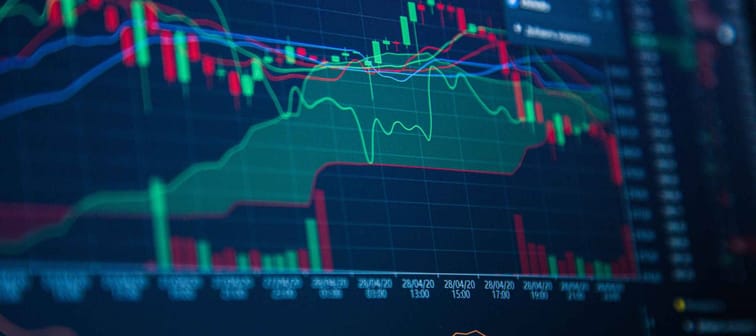What is a stock chart?
A stock chart is a visual representation of a large amount of financial data. It is a graph that communicates information about the performance of an individual financial security, specific index, or the entire stock market in a concise, simple to read way.
A stock chart can be used in combination with other financial metrics to assess a security, such as P/E ratio, dividend payout ratio, bid/ask price, and so on. Many traders, however, will rely on the stock chart alone to determine their investment decisions.
How to understand the pricing of a stock based on a chart
A stock chart is a graphical representation of a stock price over time. A stock chart updated live will provide you with a security’s real-time price, but the most valuable part of a stock chart is historical price data. In a stock chart, you can see the historical price of a security over the time interval you choose, whether a few hours or a number of years.
All stock charts fundamentally communicate stock price over time, but there are different types of stock charts that provide additional, more detailed data. Which stock charts you prefer to use to assess a security’s performance will depend on what data you want to evaluate, as well as your personal preferences.
Different kinds of stock charts
There are 3 main stock charts to consider: line graphs, bar charts, and candlestick charts. Here’s a brief explanation and how to read each one.
How to read a line stock chart
A line graph is probably the first one you picture in your mind when you hear the words “stock chart”. A line stock chart simply consists of a simple line indicating a financial security’s closing price over time.

Along the x-axis or horizontal axis (bottom of the graph) represents time. It can be set to hours, days, weeks, or years. The y-axis or vertical axis is the stock price in dollars. The stock chart data points are plotted as the stock price at a specified period in time.
The line graph stock chart is drawn simply by connecting the dots.
How to read a bar stock chart
Despite looking considerably different, a bar stock chart communicates the same information as a line stock chart, but with more detail. A bar stock chart provides you with the range, as well as both the opening and closing price of a financial security, in a specific period of time. Like the line graph, this data is plotted over hours, days, weeks, or years so you can readily see patterns.

Each bar on the bar graph represents the range in price. Tall bars mean the price has changed a lot in that period of time, and small bars mean there has been less price movement.
On the left side of each bar, you’ll see a small tick. This indicates the opening price. On the right, the tick marks the closing price. If the opening price is lower than the closing price, then the tick on the left of the bar will be lower than the tick on the right, and the bar will be coloured green.

Right away you can see for every green bar, the stock closed at a higher price than it opened. If the opening price is higher than the closing price, the left tick will be higher than that on the right and the bar will be red.
Bar charts give you more information than simple line charts because you can see price movement. This will give you a clue to a financial security’s volatility. Large bars show big fluctuations in price, whereas short bars mean less volatility.
How to read a candlestick stock chart
A candlestick stock chart looks intimidating at first, but if you already have a handle on reading line graphs and bar stock charts, you’ll get the hang of it quickly. Like the bar stock chart, a candlestick stock chart communicates open and closing prices, as well as the price range of a financial security. With a candlestick chart, the colours actually indicate the security’s performance to the previous time interval.
The rectangular body of the candlestick represents the opening and closing prices. The bottom of the body is the opening price, and the top is the closing price. If the stock closed higher than its opening price, the candlestick is hollow. If the stock closed lower than its opening price, the candlestick will be coloured in.

There are lines above and below the candlesticks, referred to as its “wicks” (top) and “tails” (bottom). These show the highest and lowest prices the financial security reached in that time. The length of the candlesticks, as well as the lengths of the wicks and tails, tell us how much volatility and range there is in a stock’s price during a specified time interval.
If the stock is trading higher than the previous interval, which could be the previous day or hour or even a few minutes, depending on what chart you’re looking at, the candlestick will be green. If the stock is trading lower than its previous interval, the candlestick will be red.
From this information, we can readily see that a stock chart with many hollow green candlesticks has a positive price trend. A stock chart with coloured in red candlesticks is trending down.
How to use this information as an investor
Since stock charts communicate so much information in such a condensed way, you can learn a ton about a financial security’s performance in just one chart.
How to understand and follow trends
The most valuable information gleaned from a stock chart is a stock price over time. This is the stock price trend. Being able to readily see if a stock price is going up or down (or staying put) over time tells you a lot about its volatility, past performance, and helps you predict future performance.
Nothing can predict the future with certainty, but the best indicator of future performance is past performance. You use stock charts to follow trends of an individual security or index or market performance to make your trading decisions.
Visualizing trading volume
Along the horizontal of a stock chart, you will typically see a bar graph with green or red bars for every data point on the stock chart. These bars represent trading volume, or how many trades were made during that time period. Tall bars indicate a lot of trading activity, but not always, correspond with a large fluctuation in stock price. Short bars indicate less trading activity, and often but not always, correlate with less variation in stock price.
Identifying stock events
The stock price movements you see in a stock chart often correlate to events for that financial security. On a chart you readily see events like:
- Dividend payments
- Stock splits
- Earnings calls
If you’re viewing a stock chart and see a dramatic change in price or trading volume, look to see if there was an event like a stock split or dividend payment that day.
Where to trade
Now that you’re equipped with the knowledge of how to read a stock chart, you’re probably wondering where you can start investing. All you need to do is decide which platform to use to trade, and you’re all set to get started. You should also consider what type of investor you are, such as your investment goals and what risk level you’re comfortable with. There are a few different choices for where to trade depending on what you’re looking for.
Robo-advisors
Using a robo-advisor is a great option if you’re looking for a quick and simple way to invest without having to monitor your portfolio that frequently. A robo-advisor is a digital platform that allows you to customize how you want to invest, including how much risk you’re comfortable with. Then, the robo-advisor invests your money into ETFs. An advantage of robo-advisors is that usually, the related account fees are low compared to other investing methods. If you’re looking to invest conservatively and you don’t want to lose too much of your time to managing your portfolio, go with a robo-advisor. If you want to go with a robo-advisor, we’d recommend checking out Wealthsimple.
Online brokers
Online brokers make it easy and accessible for you to invest your money in the stock market. What an online broker does is allows you to open an investment account digitally. This account can then be used to buy or sell stocks, ETFs, or bonds. Your bank likely has brokers that you can work with as well, but the advantage of the online broker is that you can do everything on your own from your home and still get access to all the information you might need. Questrade is a popular online broker that offers affordable rates. It also offers many visualization options for your stock charts so you can that you can be more involved in managing your portfolio.
Using a financial advisor
If you want to get more out of your investments and online brokers aren’t cutting it for you anymore, then consider hiring a financial advisor. This option is particularly desirable if you have a high net worth or you want someone to build you a personalized investment plan. This option is typically for people investing larger amounts, such as $250,000 and above, so a financial advisor isn’t necessarily ideal for everyone.
Final thoughts
While learning to read stock charts might sound as fun as learning to read graphs in your junior high math class, it’s a crucial skill to managing your investments. Not knowing how to read stock charts means you can never be sure how your portfolio is doing. The better you get at reading stock charts, especially using additional charting tools for technical analysis, the better and more informed trading decisions you can make. Reading and understanding stock charts takes practice, but it’s one of the most valuable skills to managing your long-term wealth!






